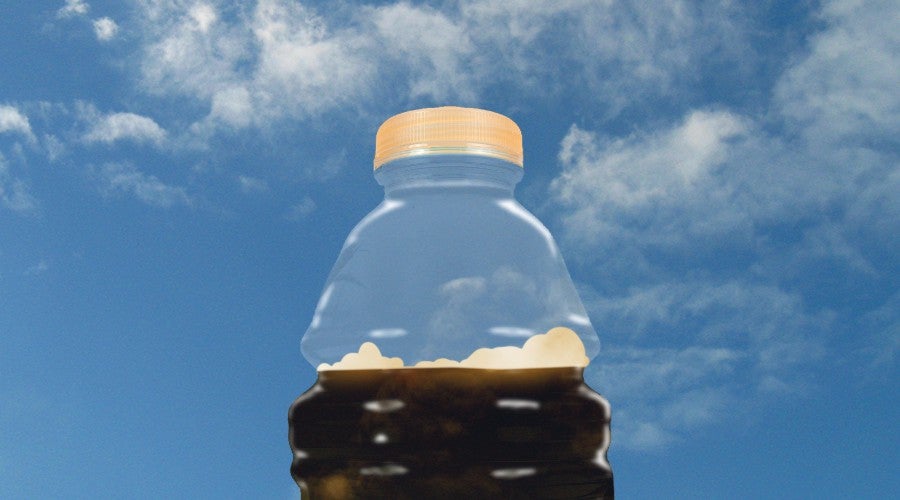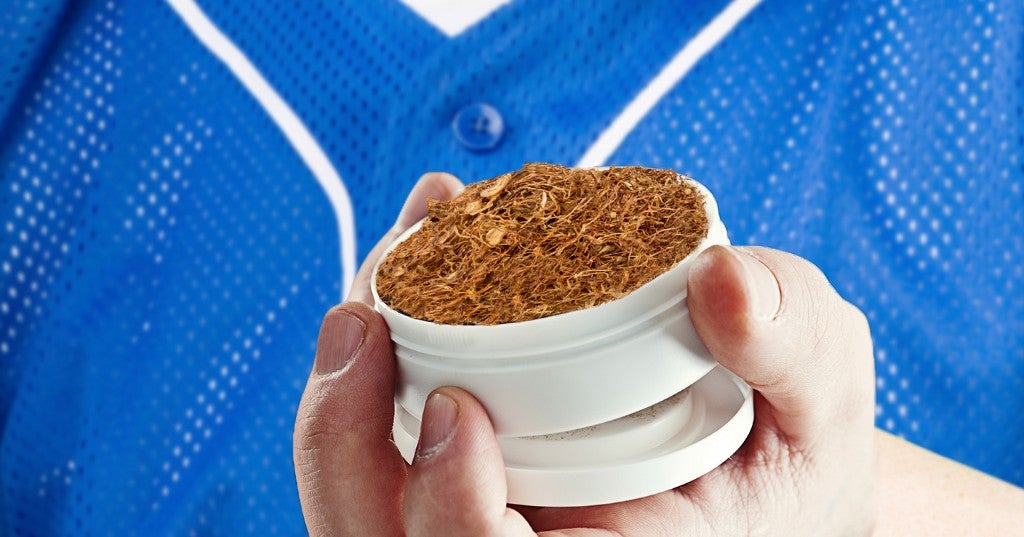When I was in high school, my Saturday morning ritual involved arriving at the football field several hours before kickoff; finding my three closest friends on the team; climbing to the last row of our extravagant, brick grandstands; and filling the space between my gums and cheek with a “pinch” of dipping tobacco. One teammate always brought a copy of the Chicago Sun-Times sports section. We’d pore over scores from the previous night’s games, discussing the best players and teams in the state while periodically spitting the tobacco’s brown viscous byproduct into empty Gatorade bottles.
That ritual now seems as arcane as smoking on airplanes. All the cool kids vape now, and cigarettes seem destined to die off with Gen-X. As such, public health officials have now focused their attentions on smokeless tobacco, ensuring the death of a distinct, substance-based culture.
The latest blow to dipping culture has been its exclusion from some of the nation’s most prestigious sports venues. Chicago and New York recently joined Boston, Los Angeles and San Francisco as cities that ban the use of smokeless tobacco in their sports stadiums. It’s an obvious attempt to end smokeless tobacco’s close relationship with certain sports (particularly baseball). The Chicago and New York bans will go into effect later this summer, much to the chagrin of players and fans.
“We’re grown men,” Cubs pitcher John Lackey said in an interview with ESPN. “People in the stands can have a beer, but we can’t do what we want? That’s a little messed up.”
And Lackey’s frustration is understandable. Not because of his lame attempt to equate tobacco with alcohol, but because dip is one of the few substances allowed to athletes.
My friends and I relished those early-morning dip sessions specifically because we played football. As athletes, we were subject to a litany of restrictions — GPA requirements; curfews; dress codes; stringent policies regarding attendance, tardiness and hallway and classroom behavior — that, if broken, resulted in a serious ass-chewing from the coaches and discipline in the form of torturous exercise. We once ran stairs until a teammate wept, and that was just because a different teammate forgot his cleats at home.
Weed was hard to come by, not to mention prohibitively expensive for a bunch of teenagers with no incomes. And getting caught with it meant almost certain dismissal from the team (if not expulsion from school). Drinking was slightly more acceptable in athlete circles, although the risks were almost as high — underage drinking was heavily policed in our suburban town, and the minimum consequence was a three-game suspension, plus whatever legal penalty you were handed.
Smoking cigarettes was unthinkable. We couldn’t imagine inflicting that kind of damage on our respiratory systems.

But dip afforded a rare opportunity to transgress. Not only were we using tobacco, we were doing so discreetly and on school grounds. We didn’t realize it then, but what we engaged in was not so much an act of rebellion so much as it was a carefully-orchestrated male bonding practice.
Not that the buzz wasn’t nice, too. Dipping was especially satisfying after a particularly tiring game or practice. The muscle fatigue combined with the head rush to create an almost zen-like relaxation.
Our informal name for dip was “chaw.” To “pack a fat chaw” (or “pack a fatty”) meant to stick a considerably large wad of tobacco wisps against your cheek. Sometimes a guy would try to prove his toughness by packing a “horseshoe,” (i.e. filling the entire length of his gum line with dip, thus creating a continuous “U” of tobacco). This rarely ended well.
People who never chawed often mistakenly call it “chew,” which was another substance and culture all its own. Short for chewing tobacco, it was loose strands of tobacco leaf that came in sealed, three-ounce pouches. None of us ever dared fuck with it. The thought of gnashing on balled up wads of tobacco always struck me as unbearably gross. This is probably The Sandlot’s fault.
Looking back, my teammates and I weren’t being all that transgressive; this was a behavior we learned behavior from our coaches, nearly all of whom dipped openly throughout every practice. You’d mess up a play or drill, and suddenly you’d find yourself face-to-facemask with a fuming 35-year-old man, his mouth close enough to smell the aroma emanating from his massive chaw.
An integral part of the dipping ritual was packing the tin — the dipper’s equivalent of a smoker beating a fresh pack of cigarettes against his palm. Packing a tin was surprisingly difficult to master. It involved holding the tin between your thumb and middle finger and whipping your wrist such that your index finger slapped against the lid. This required keeping your index finger loose, and few possessed the finesse to do it well. Acquiring this skill led to this obnoxious habit of pretending to pack a tin when we weren’t even holding one. You’d be in class and reflexively start thrashing your wrist, your index finger audibly slapping against your middle phalange, much to the annoyance of those around you.
As high school continued, dipping permeated corners of my life beyond football. By the time I graduated, just about all of my friends dipped with some frequency. We most often did it while playing poker. This was back in the mid-aughts, when the U.S. was in the throes of a full-fledged poker craze. ESPN was airing poker tournaments pretty much non-stop at the time, and suddenly being a degenerate Vegas gambler seemed like an honorable way to make a living. We’d gamble for hours in someone’s attic or basement, all the time slowly increasing our chances of mouth cancer.
Sometimes, someone from outside our immediate circle of friends would sit in on a poker game, let his curiosity get the best of him and try dipping for the first time. Invariably, this person would get sick. (Everyone does their first time.) He wouldn’t know how often he needed to spit, so he’d end up swallowing some of the ghastly dip juice that had accumulated in his mouth. Then he’d turn a ghostly shade of pale and gag uncontrollably while someone mocked him for being such a “pussy.”
I have a similar reaction whenever I think back on my old dipping habit: I retch in disgust, and am bewildered I ever romanticized something so blatantly unappealing. Which is why we’re better off putting an end to dipping culture.
MLB says it has long supported a universal ban on smokeless tobacco, and it’s currently negotiating one as part of the league’s next collective bargaining agreement. But MLB players are likely to push back. More than a quarter of them still use smokeless tobacco, and some of them view it as integral to the game as hot dogs and fireworks.
“It sounds bad, but it’s part of the game,” Thomas Eshelman, an NCAA pitcher at Cal State Fullerton, said of smokeless tobacco last year.
The resistance is puzzling given how tough MLB and other professional sports have been on other vices. After years of ignoring rampant steroid use, MLB has cracked down on performance enhancing drugs over the past decade. The NFL has made a concerted effort to make the game safer amid concussion worries and has started to levy heavy penalties on players who commit domestic abuse. And the NBA has positioned itself as a champion of civil rights, banning former LA Clippers owner Donald Sterling from the league for racist remarks and threatening to move the 2017 All-Star game out of Charlotte unless North Carolina retracts its controversial, transphobic “bathroom law.”
Yet baseball players are reluctant to give up an addictive, cancer-causing substance, all because of some outmoded sense of tradition.
I graduated to smoking cigarettes after my athletic career ended in high school, and it was a different culture — one that included women and took place mainly in beer gardens — but the conviviality was familiar. It’s fun to exclude yourself to do something detrimental to your health, especially if you have friends there to make it seem okay. It recreates the feeling of having teammates, of being in on something together. But that’s also what makes quitting so difficult. I was never really there for the high; I was there for the people.
John McDermott is a staff writer at MEL, where he recently wrote about how geek culture, superheroes and the insanity of movie marketing.
More sports from MEL:
- The World’s Greatest Batting Stance Imitator Just Wants to Go Pro
- Welcome to FrampCamp
- The NFL’s Forgotten Retirees
